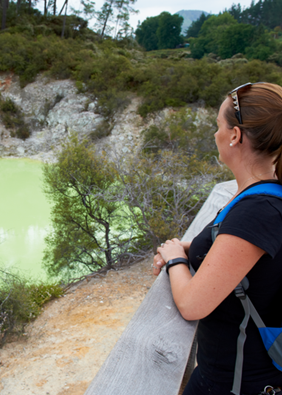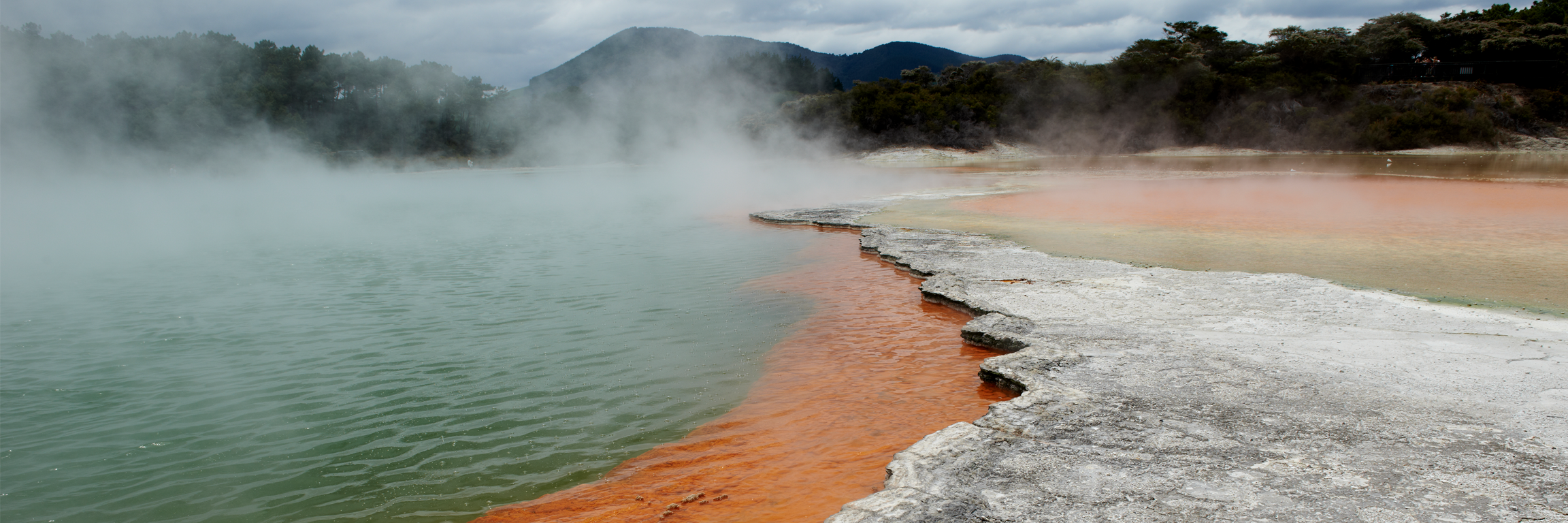"The challenges of the past and the competing views on how geothermal systems should be used and cared for in the future underscore just how critical it is to collect good scientific information to properly inform decision making."
- Waikato Regional Council Mātauranga Māori Scientist Oliver McLeod

Artist’s Palette, Ōrākei Kōrako
The Waikato region contains 70 per cent of New Zealand’s geothermal systems.
From kaleidoscopic sinter terraces and brilliant bubbling geysers to hot pools that warm the body and nourish the soul, our region's geothermal areas are unique and internationally renowned.
Like many beautiful things, they’re immensely valuable too – culturally, scientifically and economically. And, like many beautiful things, they’re also fragile and vulnerable.
The history of geothermal use in New Zealand has been heated and often highly emotive, with disputes over land and competing views around how geothermal systems should best be cared for and used.
The role of Waikato Regional Council today is to strike the balance to ensure these taonga (treasures) continue to enrich the lives of those here now and generations to come.
“It’s safe to say a lot of mistakes were made in the past when it comes to managing New Zealand’s geothermal systems,” says Waikato Regional Council Geothermal Scientist Katherine Luketina, who was recently recognised by international professional network Women in Geothermal for her work in this field.
“From the early 1900s until the late 1980s exploitation of these systems was common and businesses and authorities often had limited knowledge of the damage they were doing.
“But, thankfully, from the 1980s onwards – coinciding with the formation of Waikato Regional Council in 1989 – attitudes began to shift, and monitoring regimes were introduced, along with much more effective regulation.
“Today we have a framework in place to protect geothermal sites and iwi are increasingly involved, with three of the five developed systems in our region now owned and operated by Māori and a peer review panel with iwi representation overseeing decision-making in the management of all our developed systems.”
Since 2003, when Waikato Regional Council’s geothermal policy was introduced, no protected geothermal features have been lost, with only very limited losses occurring as a result of unconsented activity, natural events and wildfires.
The demand will always exist, however, to use more geothermal resources for a range of productive purposes.
Making productive use of geothermal energy is nothing new. It was used by Māori long before European arrival for things like cooking, bathing and heating, and still is. But today, the use of geothermal systems for tourism, science and renewable energy also represents a cornerstone of the regional economy.

Rotokārikitea, Wai-o-tapu
Tourism brings in around $17bn each year to New Zealand and around a fifth of overseas visitors to the Waikato region visit at least one geothermal site during their stay, supporting tens of thousands of jobs.
The scientific value of geothermal microbiomes is also significant. There’s more microbial biodiversity in New Zealand’s geothermal areas than the rest of the country combined. Microbes extracted from geothermal environments are even used in forensics to help solve crimes.
And, geothermal is an important renewable energy source, producing around 18 per cent of the country’s electricity.
“But, in te reo Māori, there’s a phrase that really resonates when we think about the importance of our region’s geothermal systems,” says Mātauranga Māori Scientist Oliver McLeod, “Kei pātai ngā mokopuna; I ahatia e koe taku taonga? Let not our descendants ask; What did you do to my treasure?”
“The challenges of the past and the competing views on how geothermal systems should be used and cared for in the future underscore just how critical it is to collect good scientific information to properly inform decision making.” says Oliver.
“It also shows how important it is to engage with iwi and incorporate Māori knowledge to better understand how we can protect and use these places together so they can continue to be enjoyed by future generations”.
Waikato Regional Council has a five-tier management system to classify geothermal systems based on ranking their characteristics. There is a different management approach for each category, and the system is used to balance development that benefits communities with the protection of highly valued surface features.
Every quarter, features throughout the Taupō volcanic zone are surveyed to make sure key metrics are within expected ranges.
The council’s consenting process also ensures resource use is carefully managed and the precautions people are required to take to use geothermal resources match the risks those uses pose to the environment.
Find out more about our region’s geothermal systems and how we regulate their use on our geothermal pages.



